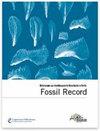下载PDF
{"title":"来自波罗的海琥珀的神秘的带刺收割机","authors":"Jason A. Dunlop, Christian Bartel, Plamen G. Mitov","doi":"10.1002/mmng.201200007","DOIUrl":null,"url":null,"abstract":"<p>A new harvestman (Arachnida: Opiliones) from Baltic amber (Palaeogene: Eocene; ca. 44–49 Ma) is described as <i>Piankhi steineri</i> n. gen., n. sp. This enigmatic fossil expresses long, slender pedipalps without a tarsal claw, which is characteristic for the suborder Dyspnoi. The chelicerae are notably enlarged and the dorsal body surface is formed from a carapace with a separate prosomatic tergite (<i>metapeltidium</i>), plus a large opisthosomal scute (or <i>scutum parvum</i>). However these characters, combined with the distinctly spiny limbs and further rows of spines across the fossil's opisthosoma, have no parallel among the modern dyspnoid harvestmen that we are aware of. The fossil resolves features reminiscent of modern members of the dyspnoid families Ceratolasmatidae, Nipponopsalididae, Ischyropsalididae and Sabaconidae, but does not show unequivocal apomorphies of any one particular family. We must entertain the possibility that this is an extinct body plan from the Eocene of north-central Europe, and we tentatively refer the fossil to a new genus in an unresolved position among the Ischyropsalidoidea (Dyspnoi). An amorphous triangular structure behind the anal region is assumed to be faecal matter, rather than part of the original anatomy. (© 2012 WILEY-VCH Verlag GmbH & Co. KGaA, Weinheim)</p>","PeriodicalId":55147,"journal":{"name":"Fossil Record","volume":null,"pages":null},"PeriodicalIF":1.4000,"publicationDate":"2012-08-03","publicationTypes":"Journal Article","fieldsOfStudy":null,"isOpenAccess":false,"openAccessPdf":"https://sci-hub-pdf.com/10.1002/mmng.201200007","citationCount":"2","resultStr":"{\"title\":\"An enigmatic spiny harvestman from Baltic amber\",\"authors\":\"Jason A. Dunlop, Christian Bartel, Plamen G. Mitov\",\"doi\":\"10.1002/mmng.201200007\",\"DOIUrl\":null,\"url\":null,\"abstract\":\"<p>A new harvestman (Arachnida: Opiliones) from Baltic amber (Palaeogene: Eocene; ca. 44–49 Ma) is described as <i>Piankhi steineri</i> n. gen., n. sp. This enigmatic fossil expresses long, slender pedipalps without a tarsal claw, which is characteristic for the suborder Dyspnoi. The chelicerae are notably enlarged and the dorsal body surface is formed from a carapace with a separate prosomatic tergite (<i>metapeltidium</i>), plus a large opisthosomal scute (or <i>scutum parvum</i>). However these characters, combined with the distinctly spiny limbs and further rows of spines across the fossil's opisthosoma, have no parallel among the modern dyspnoid harvestmen that we are aware of. The fossil resolves features reminiscent of modern members of the dyspnoid families Ceratolasmatidae, Nipponopsalididae, Ischyropsalididae and Sabaconidae, but does not show unequivocal apomorphies of any one particular family. We must entertain the possibility that this is an extinct body plan from the Eocene of north-central Europe, and we tentatively refer the fossil to a new genus in an unresolved position among the Ischyropsalidoidea (Dyspnoi). An amorphous triangular structure behind the anal region is assumed to be faecal matter, rather than part of the original anatomy. (© 2012 WILEY-VCH Verlag GmbH & Co. KGaA, Weinheim)</p>\",\"PeriodicalId\":55147,\"journal\":{\"name\":\"Fossil Record\",\"volume\":null,\"pages\":null},\"PeriodicalIF\":1.4000,\"publicationDate\":\"2012-08-03\",\"publicationTypes\":\"Journal Article\",\"fieldsOfStudy\":null,\"isOpenAccess\":false,\"openAccessPdf\":\"https://sci-hub-pdf.com/10.1002/mmng.201200007\",\"citationCount\":\"2\",\"resultStr\":null,\"platform\":\"Semanticscholar\",\"paperid\":null,\"PeriodicalName\":\"Fossil Record\",\"FirstCategoryId\":\"89\",\"ListUrlMain\":\"https://onlinelibrary.wiley.com/doi/10.1002/mmng.201200007\",\"RegionNum\":4,\"RegionCategory\":\"地球科学\",\"ArticlePicture\":[],\"TitleCN\":null,\"AbstractTextCN\":null,\"PMCID\":null,\"EPubDate\":\"\",\"PubModel\":\"\",\"JCR\":\"Q3\",\"JCRName\":\"Earth and Planetary Sciences\",\"Score\":null,\"Total\":0}","platform":"Semanticscholar","paperid":null,"PeriodicalName":"Fossil Record","FirstCategoryId":"89","ListUrlMain":"https://onlinelibrary.wiley.com/doi/10.1002/mmng.201200007","RegionNum":4,"RegionCategory":"地球科学","ArticlePicture":[],"TitleCN":null,"AbstractTextCN":null,"PMCID":null,"EPubDate":"","PubModel":"","JCR":"Q3","JCRName":"Earth and Planetary Sciences","Score":null,"Total":0}
引用次数: 2
引用
批量引用


